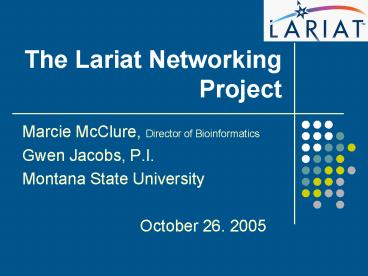The Lariat Networking Project - PowerPoint PPT Presentation
1 / 14
Title:
The Lariat Networking Project
Description:
2) Rural Health and Telemedicine in the Northwest ... Vice-Provost for Health Sciences, Montana State University and Kim Obbink, ... – PowerPoint PPT presentation
Number of Views:23
Avg rating:3.0/5.0
Title: The Lariat Networking Project
1
The Lariat Networking Project
- Marcie McClure, Director of Bioinformatics
- Gwen Jacobs, P.I.
- Montana State University
- October 26. 2005
2
What is Lariat?
- Upgrade IT infrastructure for 6 institutions in
the rural west - Upgrade internet connectivity, support IT enabled
research - Part of the IDeA program
- First phase of IDeANet
3
Lariat is a framework for connecting research
communities
- Connections to each other
- Local and regional research networks
- Public health, health disparities research
- Connections to national and international
collaborators - Strengthen existing collaborations, enable new
ones - Connections to research resources
- NCRR research resources
- National laboratories
4
Western State Networks
5
Building the framework
- Goals of the Lariat Project
- Build two networks
- Upgrade internet connectivity in 6 rural states
- Enhance and enable scientists and educators
within the region - Provide training and expertise
- Provide access to research resources
- Strengthen partnerships with other institutions
- Build national and international collaborations
6
Research Networks
Opportunities for Inclusion
7
Lariat 2006 Workshops SERVING the EDUCATION and
HEALTH NEEDS of LOCAL POPULATIONS
- 1) Advanced Research and Education Networks
Global Collaborations and - Minority-serving Colleges and Universities in
the West - Workshop leader Louis Fox, Vice Provost
Professor, University of Washington - This workshop will give an overview of
developments in advanced research and education
networks and explore opportunities for
minority-serving colleges and universities in
western states to participate in these
innovations. - 2) Rural Health and Telemedicine in the
Northwest - Workshop leaders Linda Hyman, Vice-Provost for
Health Sciences, Montana State University and Kim
Obbink, Director, Burns Telecommunication Center - This workshop will explore two interacting areas
health disparities in the rural west, and the
role of telecommunications and telemedicine in
rural health care delivery.
8
Lariat 2006 Workshops SERVING the RESOURCE
NEEDS OF BASIC RESEARCHERS
- 1) New tools for imaging activity in neural
circuits genetically encoded, fluorescent
reporters of transmembrane voltage. - Workshop leaderThomas Hughes, Associate
Professor, Montana State University - This workshop will focus on building the next
generation of genetically encoded fluorescent
proteins that respond to changes in voltage to
study the complexity of neuron connections in the
human brain. - 2) The Evolutionary Bioinformatic Network
- Workshop leader Marcie McClure, Associate
Professor, Montana State University - This workshop will provide a forum to discuss and
establish an evolutionary Bioinformatics network
among the Lariat Universities and with other
scientists who are interested in developing this
resource.
9
Seminar series opportunities for women in
Bioinformatics
- Lariat will host several women speakers who will
give accessible talks on their research and speak
on their experiences in Bioinformatics. These
events will be broadcast.
10
Enabling Expanded Research at MSU
Michael Oudshoorn, campus grid computing Yves
Idzerda, transfer data from National Synchrotron
Light Source Steve Shaw, fuel cell hosting
problem Valerie Copie, remote NMR John Peters,
remote monitoring of data acquisition and
reduction from Stanford Synchrotron Radiation
Laboratory Trevor Douglas, remote microscopy
Ed Dratz, global proteomics Gwen Jacobs,
remote access to NCMIR instruments Marcie
McClure, Genome Parsing Suite operations on
remote databases and proving a server for other
to use the GPS Lisa Graumlich, download of
LIDAR data, remote access to HPC resource
11
Genome Parsing Suite (GPS)
- The Stage I
- 1) WU-tBLASTn RT queries through database
- 2) Raw hits sorted by contig and direction
- 3) Remove WU-tBLASTn redundancy
- 4) Compound small hits likely to be from one gene
- 5) Remove false positives due to query
cross-coverage - 6) Quality assessment of unique RT hits motifs,
perfect, 1F/S, etc.
Excise 14kb DNA centered on potential RT
- The Stage 2
- 1) WU-tBLASTn each gene component through 14kb
DNA databases - 2) Raw hits for each component sorted by contig
and direction - 3) Remove WU-tBLASTn redundancy
- 4) Compound small hits likely to be from one gene
- 5) Build each Retroid genome-- using the
RT-outward approach - 6) Quality assessment of potential Retroid
genomes presence of components, stop-codons,
frameshifts and percent identity to each query
component
12
My goal is to run the Genome Parsing Suite to
find all Retroid Agents in all Genomes.
- To this end a GPS server will be developed for
general use. Many gigabytes of data will be
generated and a relational data base will be
constructed to house all results for ease of
access by the scientific community.
13
(No Transcript)
14
Contacts Gwen Jacobs gwen_at_cns.montana.edu Ron
Johnson ronj_at_cac.washington.edu Lariat
Project http//www.lariat-west.org































